Contents
How to Maintain Your Plotter for Accurate and Long-Lasting Performance
A plotter is a crucial tool for professionals in various fields, such as architecture, engineering, and design. Its accuracy and performance can significantly impact the quality of the final output. Therefore, regular maintenance is essential to ensure that your plotter operates smoothly and lasts as long as possible. This article will cover essential maintenance practices that will help keep your plotter functioning optimally.
Regular Cleaning
Dust, paper particles, and ink residue can accumulate in your plotter over time, affecting its performance and the quality of the prints. Regular cleaning should include the following:
- Exterior Cleaning: Wipe down the exterior with a soft, lint-free cloth. Avoid using harsh solvents that could damage the surface.
- Interior Cleaning: Use a vacuum with a brush attachment to remove dust and debris from inside the plotter. Pay special attention to the print head and surrounding areas.
- Cleaning the Print Head: Most plotters have a built-in cleaning function that can be accessed through the software or control panel. Running this cleaning cycle periodically can help prevent clogs and maintain print quality.
Replacing Consumables
Plotters rely on consumable parts such as ink cartridges, print heads, and maintenance cartridges. Regularly checking and replacing these components is crucial for maintaining optimal performance:
- Ink Cartridges: Monitor ink levels and replace cartridges when they are low. Using genuine cartridges from the manufacturer is recommended to ensure compatibility and quality.
- Print Heads: Depending on usage, print heads may require replacement periodically. Check the manufacturer’s recommendations for signs of wear.
- Maintenance Cartridge: This component collects excess ink and must be replaced as per the manufacturer’s instructions to avoid ink overflow issues.
Software Updates
Keeping your plotter’s software updated is essential for maintaining compatibility with design applications as well as improving performance. Updates can include enhancements to print quality and the addition of new features. Here’s how to manage this:
- Check for Updates: Regularly check the manufacturer’s website for firmware updates. Install new versions as they become available.
- Driver Updates: Ensure that your computer’s plotter driver is also up-to-date to facilitate seamless communication between your computer and the plotter.
Environmental Considerations
The plotter’s environment plays a significant role in its performance. Ideal conditions can help extend its lifespan and maintain accuracy:
- Temperature and Humidity: Maintain a stable environment with a temperature range between 20°C to 25°C (68°F to 77°F) and humidity levels around 40% to 60%. Extreme fluctuations can affect materials and components.
- Ventilation: Ensure proper ventilation around the plotter to prevent overheating, which can lead to malfunctions.
- Light Exposure: Protect your plotter from direct sunlight, which can cause damage to internal parts and affect print quality.
Using Quality Materials
The materials you use, including paper and ink, can greatly influence printing performance. Here are some recommendations:
- Quality Paper: Use high-quality paper specifically designed for your plotter. Low-quality paper can lead to jams, smudging, and inaccurate prints.
- Correct Roll Size: Make sure to use paper rolls that fit your plotter’s specifications, as improper sizes can cause operational errors.
Regular Usage and Calibration
Regular operation of your plotter can help maintain its components. Infrequent use can lead to issues like clogging. Additionally, calibration is vital to ensure accurate performance:
- Routine Printing: Use your plotter regularly to prevent ink from drying in the print heads. Performing test prints on a weekly basis can help maintain printing quality.
- Calibrate periodically: Follow the manufacturer’s guidelines for calibrating your plotter. This includes print alignment and scaling adjustments.
Record Keeping
Keeping track of maintenance activities and any issues that arise can provide valuable insights over time:
- Maintenance Log: Maintain a log of all cleaning, repairs, and component replacements to identify patterns that may signal larger issues.
- Solve Recurring Problems: Document any recurring issues so you can address them with professionals or customer support effectively.
Summary Table of Maintenance Practices
| Maintenance Task | Frequency | Description |
|---|---|---|
| Regular Cleaning | Weekly | Cleaning exterior and interior components to remove dust and debris. |
| Replace Consumables | As needed | Check and replace ink cartridges, print heads, and maintenance cartridges. |
| Software Updates | Monthly | Checking and installing firmware and driver updates. |
| Environmental Control | Ongoing | Maintaining ideal temperature and humidity levels. |
| Use Quality Materials | Every Print Job | Utilizing recommended paper and ink for the plotter. |
| Calibration | Monthly | Calibrating print alignment and scaling adjustments as needed. |
By following these maintenance practices, you can enhance the accuracy and longevity of your plotter, ensuring that it continues to meet your printing needs effectively. Regular maintenance not only saves costs in the long run but enhances the overall work workflow, providing high-quality outputs essential for professional applications.




